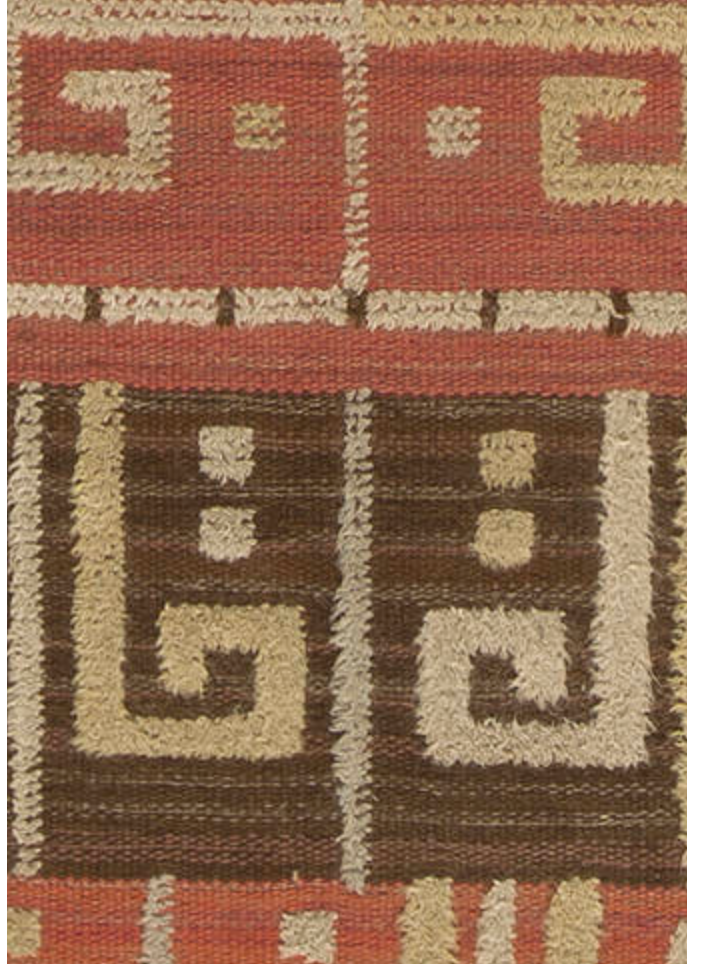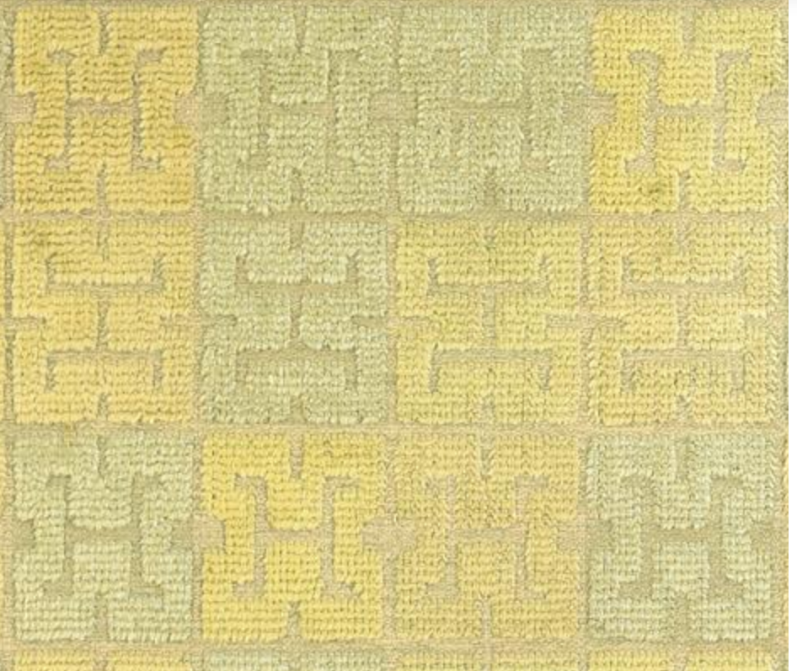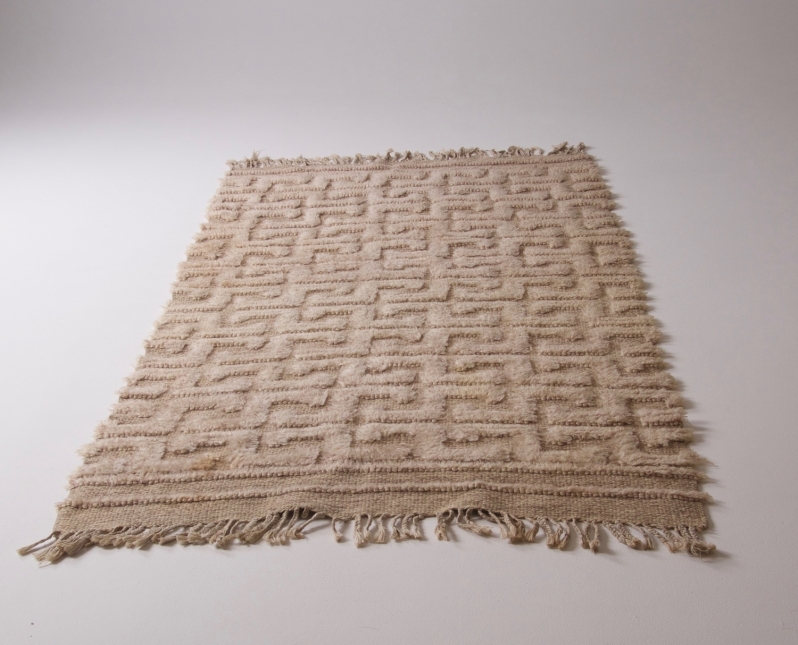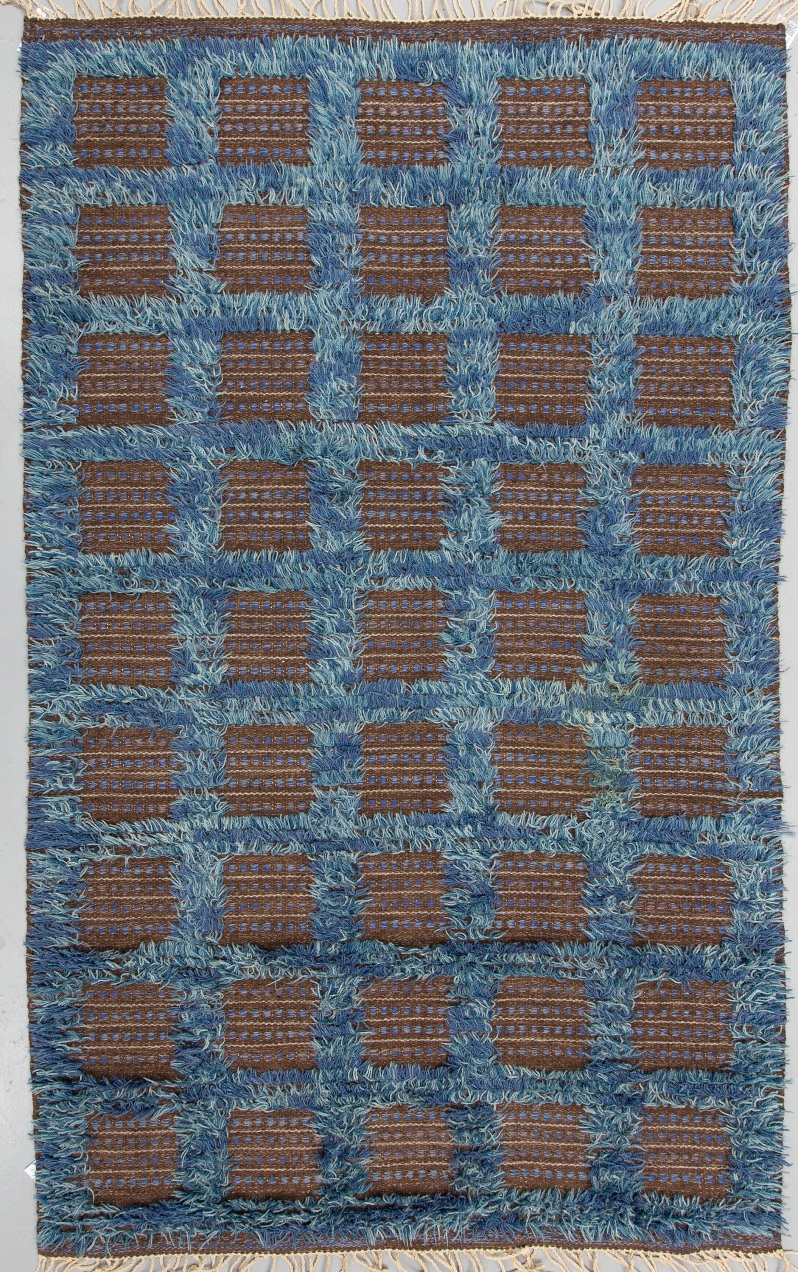They are called Halv-flossa, or Relief flossa in Swedish. And no, this is not something you use to clean your teeth. Halv-flossa or relief-flossa—translated half pile or relief pile— is the name for a kind of distinctive Swedish carpet, which seems to have been remarkably durable over the course of the 20th century. As its name suggests, the construction of this kind of rug or carpet is only partially pile, with flat-weave sections between. We see examples from the 1930s, and from the 1970s, with apparently little to distinguish them. As a style, it takes a little getting used to, particularly for those of us who grew up with bedspreads tufted in a similar manner!
There are distinctive variations on this form by a variety of talented Swedish designers including Signe Asplund, Märta Måås Fjetterstrom, Elsa Gullberg, Sigvard Bernadotte, Barbro Nilsson, Ingrid Hellman-Knafve, and Margareta Lundahl. Both light colors and white pile on white flat-weave were among its earliest iterations, but the use of colored pile or colored flat-weave sections–or both of these combined– rapidly became more common.
Signe Asplund, who ran her own carpet design and fabrication studio in Stockholm during the 1930s was known for her use of the relief flossa technique. One of her larger rugs, called “Frejamattan” was a soft rose color, and used the motifs of the zodiac. A smaller piece, shown below, was a piece of imaginary heraldry for an imaginary Swedish town (one invented by a late 19th-century cartoonist), and had ivory-colored pile, and light green flat weave sections.

The seminal white on white half-pile rug in the 20th-century was Märta Måås Fjetterstrom’s hand-woven “Vita Spetsporten” rug designed in 1934. This rug has a slightly archaic feel, with a traditional middle-eastern niche motif turned into a pointed portal. Greek frets form a kind of ground beyond the “gate, or a center to it. This is a bit unusual, since during the 1930s, the Greek fret motif was frequently used as a rug border. The MMF studio has woven this rug over the years in many sizes.

The following year, Måås-Fjetterstöm designed a half pile rug, Ursula, which also played with the Greek fret motif as an abstracted repeating figure for the rug’s center, although the colors were spring-colored rather than classical.

In 1939, in a rug she designed for the Swedish Parliament, Måås-Fjetterström found another way to revisit the classical, both in motifs and colors. She called this her Pompeian rug, and used the half-pile format to create a kind of stately formality well suited to work with the Art-deco and Swedish Grace furniture styles of the day. At the time, the classical style also seemed suitable for the heroic responsibility of those enacting the country’s laws! In an unusual inversion, with this design, Måås-Fjetterström used as much flat-weave area as raised pile, making the red-ochre (like Pompeian walls), and brown-colored areas in flat-weave background for the raised white and pale yellow Greek fret motifs.



But also in 1939, Måås-Fjetterstöm showed a more playful side with her design for a half-pile rug called Dahlia. With its basic 9-square grid pattern in spring floral colors, each square grid surrounded by quietly rounded “petal” shapes, the rug manages to be both quiet and whimsically modern.

Where all of the MMF relief pile rugs had been (and continued to be) woven by hand, the interior designer Elsa Gullberg pioneered the development of techniques to weave relief-pile carpets industrially at about the same time in the 1930s. Although she had a high-end business clientele, Gullberg was committed to the process of commercial manufacture as a way of making attractive goods more affordable for larger numbers of people. It is unclear whether these half-pile rugs as initially made by machine were as well-woven as the hand-woven versions, and given-the start-up costs, how much less-expensive they really were.
In 1935, Elsa Gullberg designed her “Chinese” rug using several colors of yarn to create an elegant iridescent look. Again, the underlying motif is a variation on the Greek fret, but it is now unrecognizable as such. The H-shaped reveal of the flat woven sections of rug instead take on a cryptic calligraphic quality. The coloration is convincingly “oriental,” recalling lacquered Chinese screens. As a floor-covering in a businessman’s office, it was definitely impressive. (See blog post of 7/1 /16 titled “Sweden’s First Interior Decorator” for a photograph of this in an office).


From the late 1940s on, Sigvard Bernadotte also designed many light-colored half-pile rugs, handwoven and marketed by Nils Nessim. Various anonymous designers also designed half-pile rugs and like Bernadotte’s, most of these also seem to be natural-colored. Comparing these rugs with MMF’s Via Spetsporten, it is evident how much this basic style continued to appeal to Swedish tastes. It provided a neutral background for any kind of furniture, often employed some derivation of the ever-popular Greek fret, and yet offered a strong textural contrast between the flat and raised pile areas of the rug.


During the 1960s, Bernadotte also designed a number of colored half-pile rugs, many of which, like Elsa Gulberg’s designs, exploited the graphic quality of repeated and flipped forms.


Ingrid Hellman-Knafve also designed multiple examples of handwoven half-pile rugs during the 1950s and 60s, and had probably woven these earlier in her career as well. She frequently explored the use of the original natural colored wool contrasted with the flat-weave sections in color. Two such rugs follow, one with a more symmetrical pattern, probably earlier, and one with an asymmetric pattern dated 1963. In both cases the use of herringbone-patterned sections recalls a very similar patterning in Signe Asplund’s “Frejamattan,” mentioned above. Thirty years had passed, but many of the ways of detailing these rugs had not changed so much.



Probably about the same time, several designers working for Sweden’s country craft associations also explored this rug form. Among these were two designers, one from Uppsala County Craft Association (Uppsala läns hemslöjd), and the other from Gävleborgs County Craft Association (Gävleborgs läns hemslöjd), produced rugs which explore more dramatically both the use of color and the contrast between flat weave and pile sections of the rugs. The first of these shown is a subtle but very sophisticated design from a not-well known designer, Margareta Lundahl, of Uppsala; the second is by an unknown designer which “carves” flat-woven sections out of pile so deep it could be a rya rug.




Like the previous anonymous designer, Sigvard Bernadotte explored the possibilities of the hand-knotted rya rug crossed with a flat-weave one. Always a master of crisp graphic design, Bernadotte created a large rug –almost a landscape in itself–in which tightly controlled explosions of fuzz, colorful deep pile, were balanced with large sections of flat-weave.



Despite Gullberg’s innovative work with textile mills, it seems like nearly all of these half-pile rugs continue to have been made by hand. By the late 1960s or 70s these rugs were clearly still of popular interest, but no longer in neutral colors. At the same time, machine-made rugs seem to have “caught up” to the hand-made and developed new technical possibilities in the nature of the weave. Several of the half-pile rugs from this period which were more radical in their designs were made by machine, even though the same designers had previously designed relief-pile rugs to be woven by hand.
Ingrid Hellman Knafve, for so long a designer of hand-weaving, turned to Kinna, a high-end Swedish carpet manufacturer, to execute her design for a fabulously fuzzy rug—again, really almost a rya in the depth of its pile — made with not just one, but rainbow-colored flat-woven sections. While the design itself of boxes within boxes dates back to designs from the 1930s, as does the ivory color, the multi-colored flat-weave subverts the tradition.


But in 2005, the Märta Måås-Fjetterström studio put a new spin on the half-pile rug. A young designer, Maria Miesenberger, abandoning the typical rectangular format of rugs altogether, designed a hand-woven half-pile rug presenting the grotesque yet fascinating image of a brain. The raised sections of cinnamon-colored pile and lower sections of flat weave combine to render an almost-photographic brain representation. The designer’s choice of relief-pile was intentional; she wanted to let the contrasting heights of pile give a visceral sense of the folds of the brain to those walking on it in bare feet!

It looks as though the half-pile rug, such a durable presence in Swedish 20th-century interior design, still has an interesting life ahead of it! Perhaps both hand-woven and machine-made examples will continue to enlarge the form’s design parameters.
Sources
Bukowskis Auction house, Stockholm
FJ Hakimian, New York
Jacksons, Stockholm
Karlsson& Wickman, Paris
Robbie LaFleur, https://robbielafleur.com/2008/09/27/halv-flossa-workshop-part-one/ and
Halv-flossa Class; Part Two
https://lindahedihn.blogspot.com/2009/12/form-och-farg-hos-marta-maas.html
Märta Måås-Fjetterström, Märta flyger igen! 90 år med Märta Måås-Fjetterström, catalog of exhibition from 3-10-2009 to 6-1-2010 at Liljevalchs konsthall, Stockholm.
AB Märta Måås-Fjetterström, http://www.mmf.se/
Sterner, Maj, Hemslöjd i Sverige, Bokförlaget Natur och Kultur, Stockholm, 1939.
Stockholm’s Auktionverk, Stockholm
https://en.wikipedia.org/wiki/Gr%C3%B6nk%C3%B6pings_Veckoblad
Wright Auction House, Chicago
Please reference as follows:
Whidden, Anne, “Halv-Flossa” theswedishrugblog (10/11/17); theswedishrugblog.wordpress.com; accessed (day/month/year)
Thanks, Robbie, and stay tuned for a new post on ryas! Anne
LikeLike
Love the soft colors.
LikeLike
You’re right– they do have a kind of cosy softness, don’t they? Thanks for reading!
LikeLike